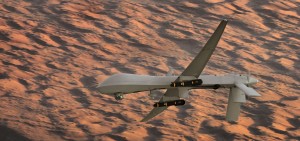WASHINGTON: The Air Force has worried for almost a decade about the strains on its workforce as it fields more and more Predators, because drones need more people to fly them than do manned aircraft. Now, the head of Air Combat Command has told his boss, Air Force Chief of Staff Gen. Mark Welsh, that he is “extremely concerned” about a “perfect storm” of increased missions and fewer pilots.
Pentagon spokesman Rear Adm. John Kirby was asked about the issue at today’s press briefing and he left it to the Air Force to discuss. My colleague Dave Majumdar at the Daily Beast got the memo.
“ACC believes we are about to see a perfect storm of increased COCOM [Combatant Commander] demand, accession reductions, and outflow increases that will damage the readiness and combat capability of the MQ-1/9 enterprise for years to come,” Dave quotes Carlisle saying in the memo. “ACC will continue to non-concur to increased tasking beyond our FY15 [fiscal year 2015] force offering and respectfully requests your support in ensuring the combat viability of the MQ-1/9 platform.”
As an Air Force officer reminded me yesterday, this is not a new issue for the service. The Government Accountability Office issued a report in April criticizing the Air Force’s management of the drone force, saying that unless the service changed how it manages its drone pilot forces “the Air Force risks perpetuating personnel shortages and may need to continue relying on manned-aircraft pilots to fill its personnel requirements.”
Here’s the nub of the report:
“Air Force guidance states that low crew ratios diminish combat capability and cause flight safety to suffer, but the Air Force has operated below its optimum crew ratio and it has not established a minimum crew ratio. Further, high work demands on RPA pilots limit the time they have available for training and development and negatively affects their work-life balance. In addition, the Air Force faces challenges recruiting officers into the RPA pilot career and may face challenges retaining them in the future. High-performing organizations tailor their recruiting and retention strategies to meet their specific mission needs, but the Air Force has not tailored its approach to recruiting and retaining RPA pilots nor considered the viability of using alternative personnel such as enlisted personnel or civilians.”
I checked the report to see if the recommendations GAO made to the Air Force had been adopted, rejected or acted on. All are marked as Open, meaning that GAO has not verified any changes made by the Air Force.
So it may be that Hawk Carlisle, who only took over as head of Air Combat Command in October, doesn’t know about this part of the puzzle yet. The normal action of a service faced with a problem like this is to throw money at it. And I understand there is a good chance that the Carlisle will get more money for more pilots in the upcoming budget.
It takes more than 80 people to fly a full complement of four Predators for 24 hours. And there are a lot of Predators flying. They are operating over Iraq, Syria, Pakistan, Yemen and probably a whole lot of places we don’t know about on any given day. But more pilots may not solve the longer term problem. As the drawdown presumably proceeds over the next few years, the Air Force may shrink a bit more. If military pay does not increase at the same rate as in the civilian world you may see more people leave.
This is exactly the kind of problem that increasingly will afflict the US military as money shrinks but its global missions persist.
In a ‘world first,’ DARPA project demonstrates AI dogfighting in real jet
“The potential for machine learning in aviation, whether military or civil, is enormous,” said Air Force Col. James Valpiani. “And these fundamental questions of how do we do it, how do we do it safely, how do we train them, are the questions that we are trying to get after.”




























